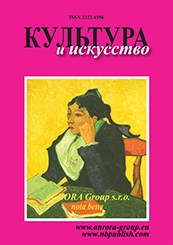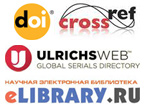Audiovisual culture and art
Reference:
Evallyo, V.D. (2019). Soviet Ideological Films and Searches for New Cinematographic Language in the 1960s - 1980s. Culture and Art, 8, 1Ц10. https://doi.org/10.7256/2454-0625.2019.8.30328
Abstract:
The article is devoted to the brightest experiments with a split screen and the use of this technology by Soviet stage directors during the era of stagnation. The aim of the research is to describe aesthetical goals achieved by the use of a split screen and their influence on the poetics of cinematograph. The author of the article focuses on the semantic functions of a split screen that were typical for the Soviet cinematograph. He analyzes works of different genres in order to compare functional and aesthetical features of a split screen in popular-science films of Kirill Dombrovsky, documentaries of Alexander Shein and feature films (Yevgeny Matveyev, 'Victory'). The methodological basis includes comparative, structural-functional and semiotic methods that allow to achieve research targets. For the first time in the academic literature the author of the article suggests that cinematograph of the stagnation era is characterized with functional and formal functions. The most demanded function is visualisation of simultaneous development of parallel plotlines that makes the narration more spectacular. In his works Kirill Dombrovsky used a split screen to reinforce expressiveness, create cause-and-effect relations and demonstrate the importance of central segments. Alexander Shein's films are characterized with exaggerated patriotism with the focus on the ruling ideology. His split screen became a manifest of ultra-modern socialist system and ability of the system to speak the 'new' high-tech language. Yevgen Matveyev's split screen is meant to bring the epic air into his films. The author concludes that during the stagnation era, technological and visual innovations such as split screen characterized both films and Soviet ideology as ultra-modern and actively developing.
Keywords:
ideology, Yevgeny Matveyev, Alexander Shein, Kirill Dombrovsky, visual effects, screen art, visual culture, split screen, Soviet culture, cinema
Question at hand
Reference:
Ivinskikh, G.P. (2019). Scenic Transformations and Problems of Artistic Reception at the Turn of the XIXth - XXth and XXth - XXIst Centuries. Culture and Art, 8, 11Ц19. https://doi.org/10.7256/2454-0625.2019.8.30547
Abstract:
The object of the research is the relationship between theatre and audience at the turn of the XIXth - XXth and XXth - XXIst centuries. The subject of the research is the influence of transient processes in the society and theatre on perception peculiarities. In the course of the analysis Ivinskikh has discovered the dependence of perception on the historical background, scenic means, and recipient's life and aesthetic experience. The author of the article analyzes how, why and depending on what conditions the role of theatre for the society and the status of the artist had been changing, what changes in the theatre life had been happening as a result of overall historical reasons, what changes were immanently conditional and what changes were defined by the cultural policy. In his research Ivinskikh has used comparative and receptive approaches combined with the dialogics principles offered by M. Bakhtin and A. Ukhtomsky's idea of the 'dominant' and 'worthy interlocutor'. As a result of the research, the author of the article makes a conclusion that problems of artistic reception are different by their nature. Changes that had happened since 1917 were caused by the cardinal transformation in the structure of the audience that were unprepared to perceive theatrical performances. Changes and the breakup between theatre and audience in the post-Soviet period, especially at early 1990s, happened as a result of changing values of both artists and audience. The researcher discovers that the dominating orientation at self-affirmation and individualism in many causes blocks the opportunity of dialogue. The novelty of the research is caused by the fact that the author offers to overcome contradictions through interaction and orientation at alternative dominant, i.e. satisfaction of essential needs of the audience, instead of antagonism.
Keywords:
cultural policy, perception of art, principles of Dialogic, receptive approach, aesthetic experience, comparative approach, alternative to the dominant, status of the artist, audience, theatre
Aesthetics and theory of art
Reference:
Pankratova, A.V. (2019). Transformations of Perception and Organization of Color Environment: From Eidos to Simulacrum. Culture and Art, 8, 20Ц29. https://doi.org/10.7256/2454-0625.2019.8.30549
Abstract:
The subject of the research is transformations of color perception and color environment caused by the influence of current epistem. The research hypothesis is that changes in the deeper structures of cogitation affect perception and use of color and consequently design. Design is viewed by modernists as a social practice and cultural phenomenon which determines the main difference of color and its functions as a sign in pre-design and modern worls. In her research Pankratova has used the method of knowledge archeology offered by Michel Fouсault. Being applied to design, this method implies analysis of structural elements of the design discourse, color being one of such elements. The main conclusion of the research is that modern designers use color as a simulacrum sign. Presently, there are three basic characteristics of color whichi are color shade, intensity and lightness that describe color as something flat or part of the material world. The pre-design paradigm perceives color as eidos or part of the transcendental world. The main characteristics of color eidos are three-dimensionality, transparency, shine and analogousness. The main distinguished feature of color in the pre-design world is additional dimension. Today color is viewed and used in design as a two-dimensional surface that do not refer to any other referent. When choosing particular color, modern designers take functionality as guide and their choice of color is rather accidental.
Keywords:
transcendental, epistem, simulacrum, eidos, art Nouveau, postmodern, modernism, color, Design, sign
Music and music culture
Reference:
Tokarev, N.A. (2019). Vadim Novikov as an Artist, Professor and Music Professional. Creative Portrait. Culture and Art, 8, 30Ц39. https://doi.org/10.7256/2454-0625.2019.8.30315
Abstract:
When it comes to modern performing art in Russia, researchers mostly recall modern mucisians. As for musicians who stand at the origins of modern artistic performance, they are mostly thought of as the 'older generation' whose work is not so important today. Their activity is viewed mostly as a compilation of achievements of the past. As a result, analysis of Russian musicians who founded the 'new' performing school is a topical issue for research. In this article Tokarev covers performing, teaching and social activity of Vadim Novikov, the leader and participant of the process of creation and development of modern trumpet playing of Moscow Conservatory. Tokarev also touches upon Vadim Novikov's innovations. The article is based on the principle of historicism as well as the methods of comparative and descriptive analysis. In addition, the researcher has also used historical chronological and problematic/chronological methods in order to successively analyze phenomena and each stage of historical development. At the present time, the personality of Vadim Novikov as the founder of solo trumpet performance at Moscow Conservatory has not been studied as fully as it should be. Available researches do not fully cover all sides of the musician's creativity. Surely, these researches contain valuable material but they either ignore special issues or are limited to particular chronological framework and this is why cannot be considered as a full research of Vadim Novikov's creative life. Tokarev describes the main contribution of Vadim Novikov into trumpet performance art and teaching performing art.
Keywords:
Moscow conservatory, Varieties of trumpets, related instruments, Brass instruments, Modern performing school, Russian musical heritage, Vadim Novikov, Creative portrait, Musical pedagogy, Solo performing art
Culture and civilization
Reference:
Fusu, L.I. (2019). The Role of Rituals in the Time of Crisis and Liminal Periods of Personality and Society. Culture and Art, 8, 40Ц45. https://doi.org/10.7256/2454-0625.2019.8.30386
Abstract:
The subject of the research is ritual practices and their role in liminal and crisis situations of society and human existence in general. The author examines such aspects of the topic as the place of crises in existence and development of the world, society and human and lilminality as a form of crisis states and rituals as the means of adaptation to liminal states and protection of negative consequences of crises. Fusu focuses on the importance of rituals for supporting the integral sense of Self concept and social solidarity in the society. The article is based on the psychoanalytical approach. As an alternative, the author also applies the analytical and philosophical paradigm and uses comparative method, analysis and synthesis. The author's special contribution are caused by the fact that the author analyzes the role of rituals for an individual and society in situations of crisis and liminality.The main conclusion of the research is the author's thesis about the integrative role of ritual practices and that rituals bring more stability into life and world. The novelty of the research is caused by the fact that the author applies provisions of the analytical philosophy to the problem of liminality.
Keywords:
the border situation is being, consciousness, cognitivism, psychoanalysis, Liminality, society, personality, ritual, terminal state, social solidarity
Culture and authority
Reference:
Devyatov, V.S. (2019). Administrative Support of Preservation and Popularization of Folk Song in Russia. Culture and Art, 8, 46Ц53. https://doi.org/10.7256/2454-0625.2019.8.30434
Abstract:
The article is devoted to the preservation and popularization of folk song in Russia at the administrative level. Devyatov provides the results of analyzign the legal basis that regulates administrative support of these processes both at the federal and regional levels. He also describes conditions and means of development of folk song and examines practical aspects of their realization. The main method of the research is analysis of legislative acts and other official documents that regulate the issues arising in the process of preservation, distribution and popularization of amateur and folk arts. As a result of the research, the author describes both positive aspects of state activity in the sphere of folk culture and problems that restrain the processes of preservation and popularization of folk song in Russia at the governmental level. Based on the analysis of modern practice of Russian folk song, Devyatov describes difficulties and prospects for the development of folk song under modern economic and socio-cultural practices.
Keywords:
municipal authorities, legal regulation, cultural policy, folk song culture, folk art, folk song, administrative support, cultural institutions, amateur groups, Russia
Theoretical culturology and the theory of culture
Reference:
Popova, O.V. (2019). Artistic Heterotopy as a Term of Modern Art Studies. Culture and Art, 8, 54Ц59. https://doi.org/10.7256/2454-0625.2019.8.30435
Abstract:
The subject of the research is heterotopy as a concept that can solve a number of serious issues in art studies. The aim of the research is to demonstrate that the concept of heterotropy can be used to describe artistic phenomena that cannot be analyzed by the methods that are traditionally used in art studies. In her article Popova tries to prove that the concept of artistic heterotropy can be useful to analyze polysemantic artistic phenomena created at the border between art and science, art and life, art and social practices. In her research Popova combines spacial and linguistic approaches of Michel Foucault in interpretation of heterotropy essence. Conceptualization of the concept of heterotopy is based on the view of heterotopy as a specific semiotic mechanism of 're-scription' (according to N. Rudenko). Popova describes the following features of artistic heterotropies: they are based on the transition of an object into the space of an artwork; semantics of such an artwork is formed at the crossing of different meanings in which several semiotic systems are expressed at once; and such artwork is based on an artist's desire to destroy customary patterns and create an alternative image of the world.
Keywords:
postmodern methodology, properties of heterotopy, mechanisms of heterotopy, ready-made, contemporary art practices, Science Art, Michel Foucault, heterotopy, re-scription, contemporary art history
Symbol, word, speech, language
Reference:
Chistova, L.D. (2019). Alfabeto Figurato of Giovanni Battista Bracelli as the Monument of Visual and Written Culture. Culture and Art, 8, 60Ц67. https://doi.org/10.7256/2454-0625.2019.8.30225
Abstract:
The article is devoted to the analysis of an understudied etching Alfabeto Figurato of a Florentine artist Giovanni Battista Bracelli. Chistova analyzes this memorial as part of visual culture along with other figure alphabets and combinative images and as part of written culture covering, in particular, development and peculiarities of different handwritings. Writings of this kind, from the one side, have numerous predecessors among medieval book initials and, from the other hand, were perceived by conditionally baroque aesthetics of surprise that welcomed the combination of remote objects for illustration with the help of metaphors showing the paradoxicality of existence. In her article Chistova has used iconological analysis that implies attraction of a great number of analogies similar to the memorial of prototypes such as Menschenalphabet of Peter Fletner and less obvious analogues such as texts and engravings from compositions of Geoffroy Tory and structural-semotic methods of analysis. In the course of the research the author has discovered peculiarities of the composition and program of Alfabeto Figurato that resemble Bracelli's more famous work Bizzarie di varie figure. She also reveals the meaning of the last symbols of the alphabet. These symbols are not letters and demonstrate specific features of the composition that is close to the genre of cariccio.
Keywords:
aesthetics of surpise, roman script, cursive, combinative images, figure alphabet, Giovanni Battista Bracelli, baroque, mannerism, etching, neoplatonism
Cultural heritage, tradition and innovation
Reference:
Komlev, Y.E. (2019). The Role of Orenburg Museum in Preservation of Cultural Legacy. Culture and Art, 8, 68Ц81. https://doi.org/10.7256/2454-0625.2019.8.30290
Abstract:
In his article Komlev analyzes the role of Orenburg Regional Museum of History and Regional Studies in the preservation of cultural legacy starting from the XIXth century till today. This is one of the oldest museums in Russia. It was founded on November 12, 1830 when Pavel Sukhtelin was Orenburg military governor. Komlev wrote his article based on the analysis of archives of State Archive for Orenburg Region and archives of Orenburg Regional Museum of History and Regional Studies. Komlev has analyzed the history of the development of this museum and describes the experience of the Museum in answering the challenges of the time and becoming a modern institution at the turn of the XXth - XXIst centuries.
Keywords:
The role of the Museum, Orenburg region, The Museum at school, Dal, Zan, Sukhtelen, Neplyuevskoe School, the establishment of the museum, History of Orenburg Museum, Scientific Archive Commission
 This work is licensed under a Creative Commons Attribution-NonCommercial 4.0 International License.
This work is licensed under a Creative Commons Attribution-NonCommercial 4.0 International License.
 Eng
Eng












 © 1998 Ц 2025 Nota Bene. Publishing Technologies. NB-Media Ltd.
© 1998 Ц 2025 Nota Bene. Publishing Technologies. NB-Media Ltd.




